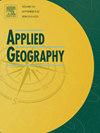Capturing the distance decay effect of amenities on housing price using explainable artificial intelligence
IF 4
2区 地球科学
Q1 GEOGRAPHY
引用次数: 0
Abstract
Automated valuation models (AVMs) have been significantly enhanced by machine learning techniques, continuously improving accuracy and flexibility in data structure and statistical assumptions. However, the complexity of machine learning models also creates challenges in interpretability, often rendering them as 'black box' models, which complicates understanding and acceptability in practice. In this context, this study uses Shapley Additive exPlanations (SHAP), a prominent explainable artificial intelligence (XAI) technique, to explore the influence of housing characteristics on price valuation in Greater Sydney, specifically aiming to capture the non-linear distance decay effect of amenities on housing price, which has been underexplored in previous studies. The results of applying SHAP in this study reveal that location characteristics, represented by accessibility to amenities, are the most important features in housing valuation models. Furthermore, the study shows that the non-linear contribution to housing price is dynamic by distance and diverse by type of amenity, such as education, transportation, and community facilities.
求助全文
约1分钟内获得全文
求助全文
来源期刊

Applied Geography
GEOGRAPHY-
CiteScore
8.00
自引率
2.00%
发文量
134
期刊介绍:
Applied Geography is a journal devoted to the publication of research which utilizes geographic approaches (human, physical, nature-society and GIScience) to resolve human problems that have a spatial dimension. These problems may be related to the assessment, management and allocation of the world physical and/or human resources. The underlying rationale of the journal is that only through a clear understanding of the relevant societal, physical, and coupled natural-humans systems can we resolve such problems. Papers are invited on any theme involving the application of geographical theory and methodology in the resolution of human problems.
 求助内容:
求助内容: 应助结果提醒方式:
应助结果提醒方式:


